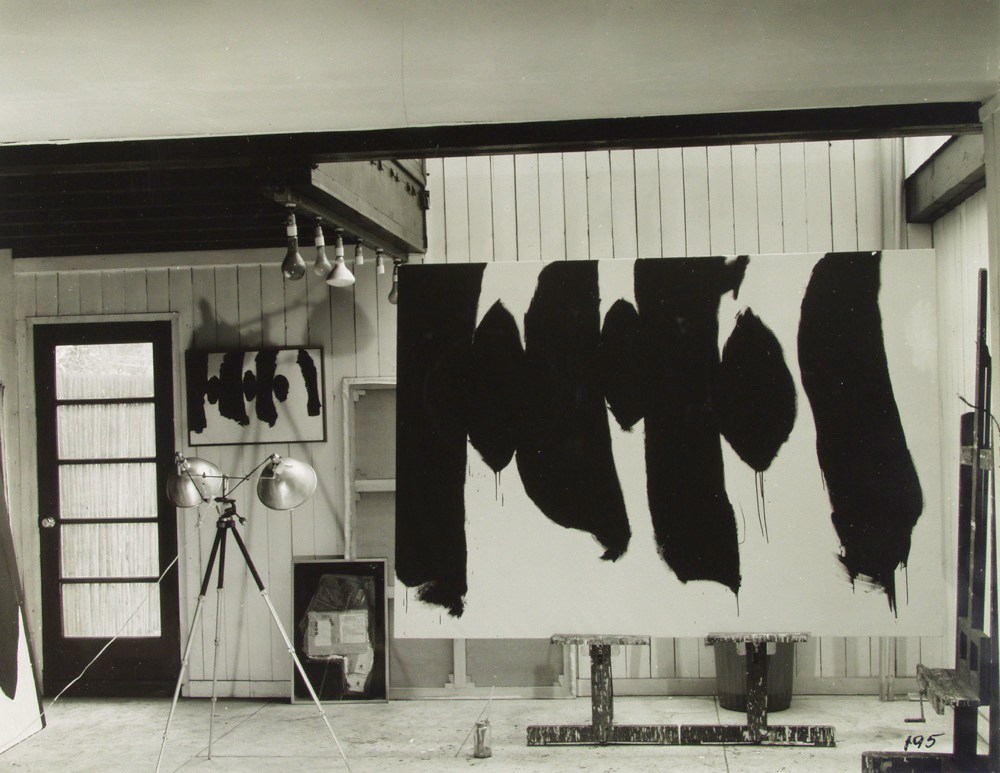Your browser is out-of-date!
Update your browser to view this website correctly. Update my browser now
1940 - 1948
Finding a Voice: Abstraction & Collage

Page from Motherwell’s Greek art lecture notes, November 13, 1940. At left is Motherwell’s sketch of the Berlin Kore
1940
Motherwell enters Columbia University’s graduate program in the Department of Art History and Archaeology, where Meyer Schapiro serves as his mentor.
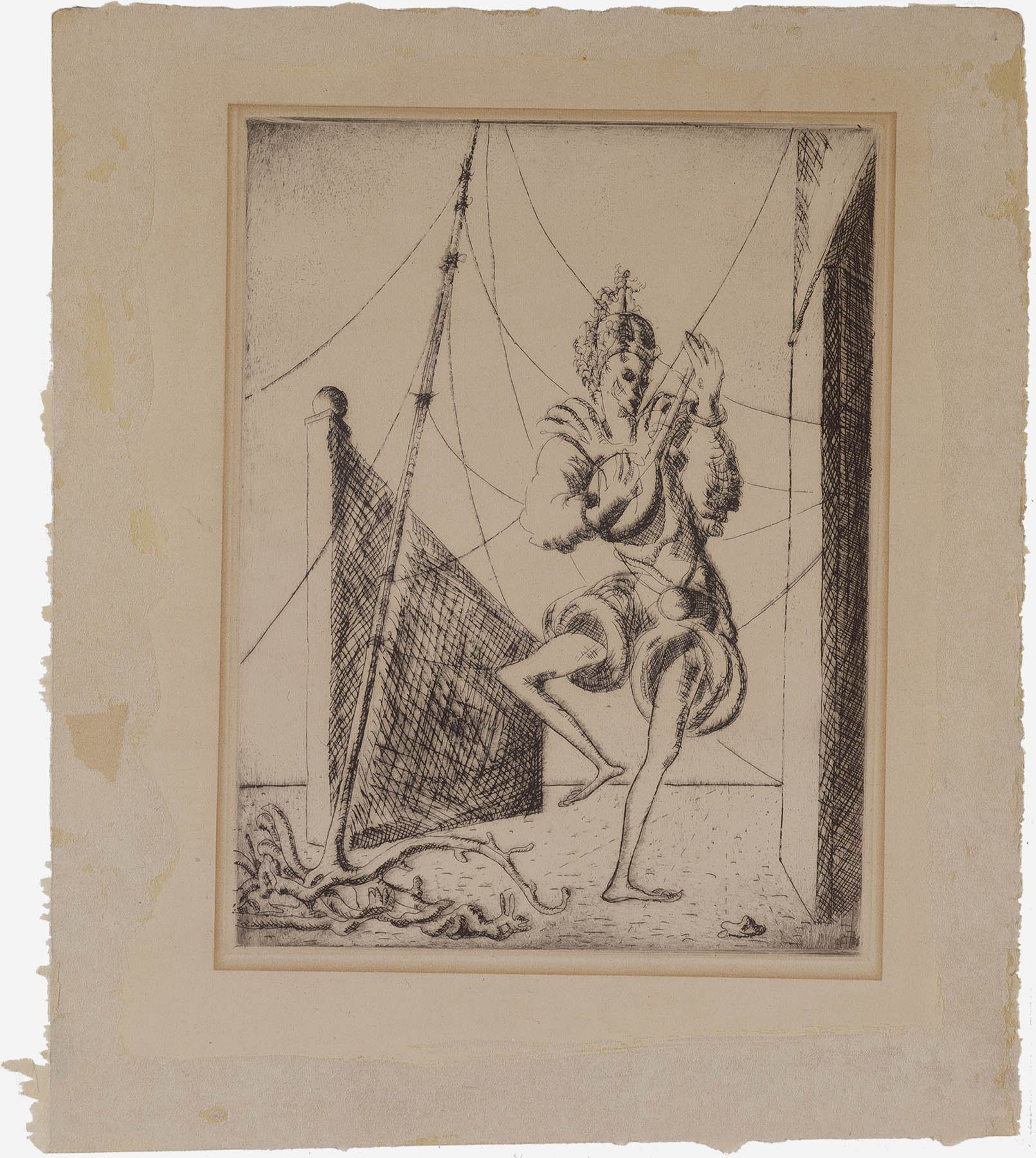
Figure with Mandoline, 1940
1940—1941
Motherwell continues to paint and frequently solicits Schapiro’s advice about his works. Schapiro, understanding that Motherwell is clearly more interested in being an artist than in his academic studies, arranges for him to study with the Swiss surrealist Kurt Seligmann. In Seligmann’s studio he makes his first etchings, including Figure with Mandoline.
1941
In January and February 1941, Motherwell attends one of a series of lectures on Surrealism given by Gordon Onslow-Ford, where he meets the Chilean painter Roberto Matta Echaurren, who will educate him on the Surrealist technique of automatism and have a significant influence on his art and thought during the next several years.
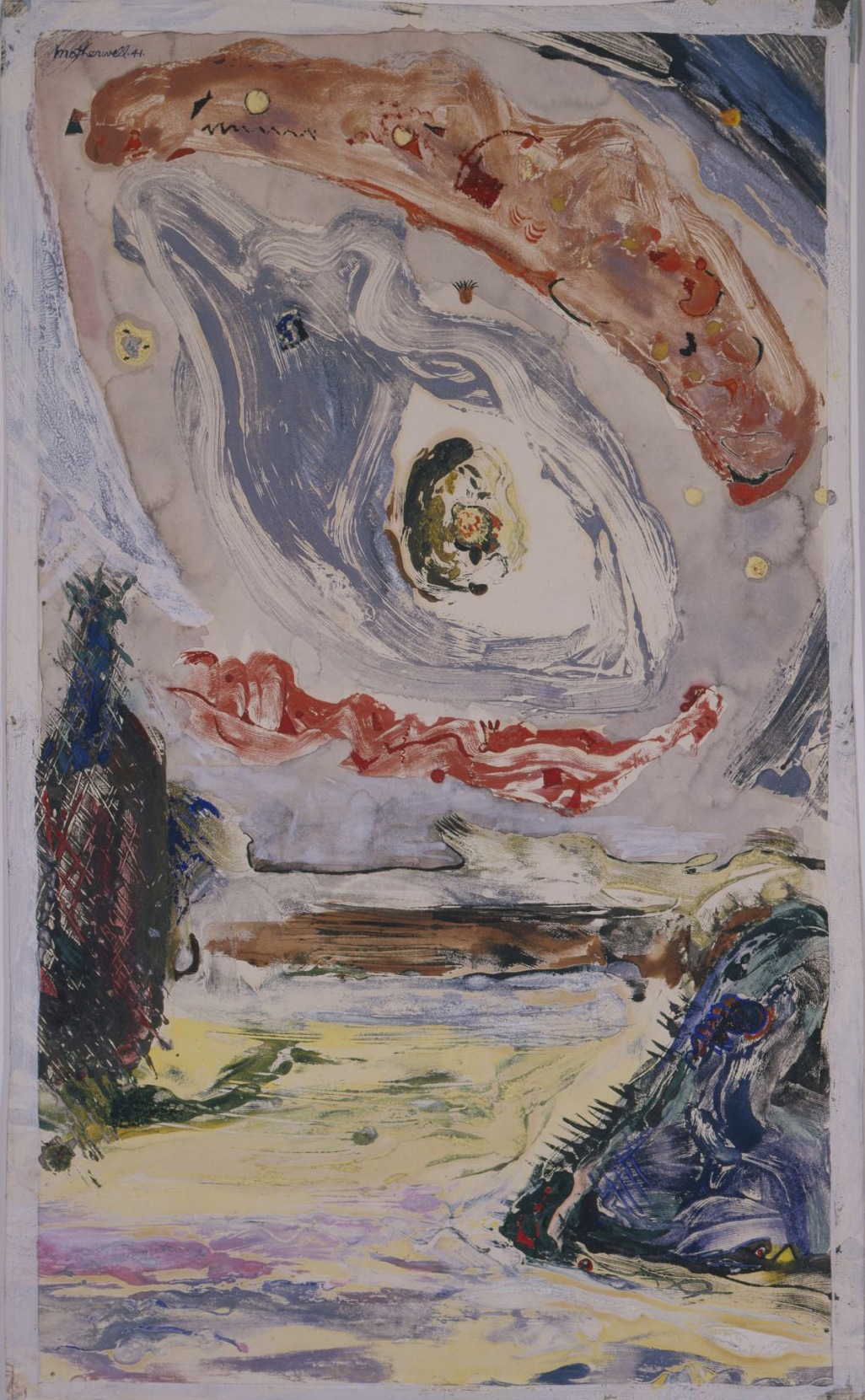
Untitled, 1941
1941
Working with Seligmann in the early spring, Motherwell creates Untitled, a monotype with hand-painted additions, one of his earliest works to show an awareness of automatist techniques.
1941
Called before his draft board, Motherwell is classified as 4F, “physically unfit for service,” because of his history of chronic asthma.
In June, Motherwell drops out of Columbia University to pursue painting full-time, despite his family’s objections.
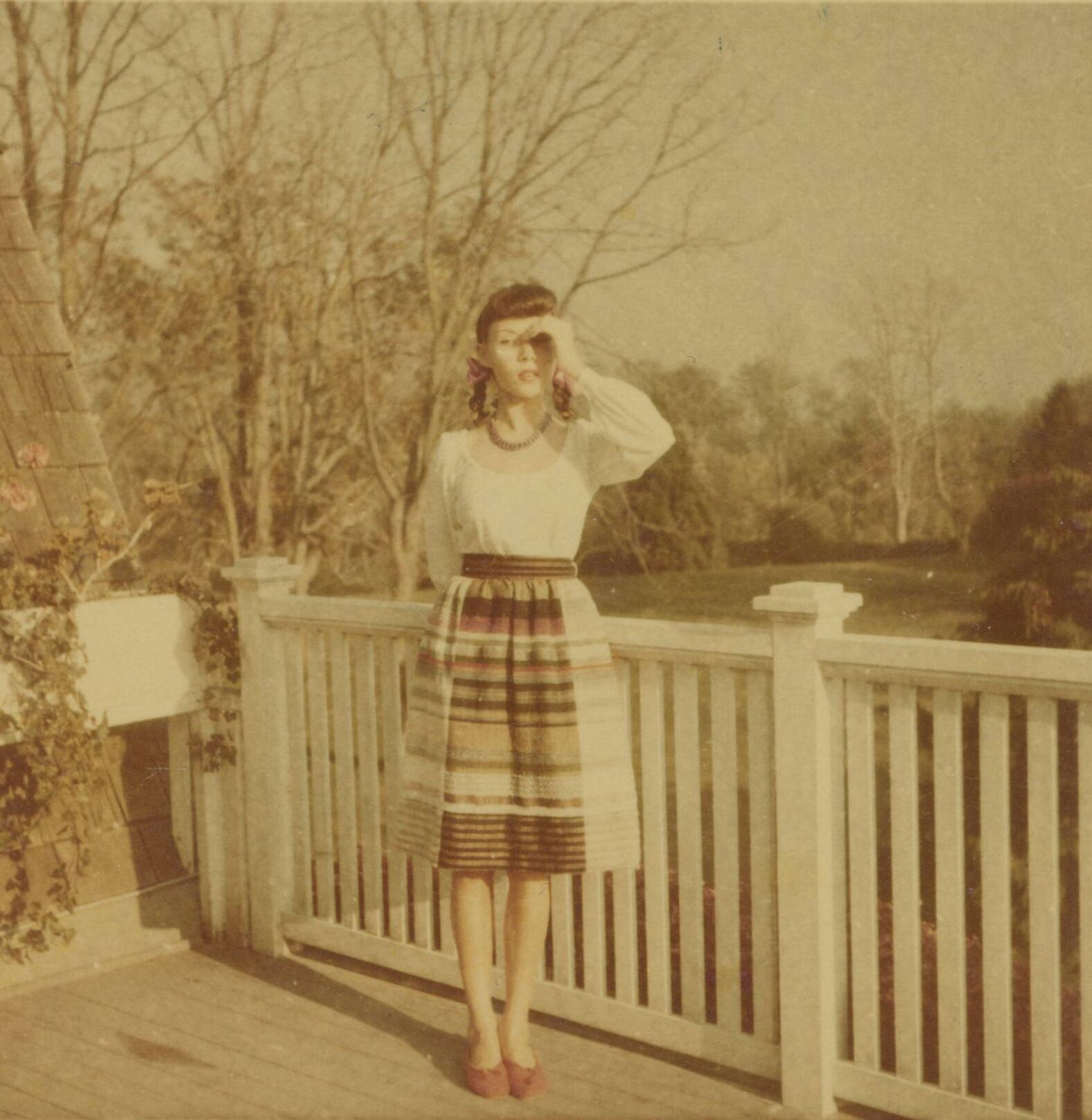

1941
Around June 7, he sails for Mexico with Matta, Anne Matta, and Barbara Reis, the daughter of the prominent New York collectors, Bernard and Rebecca Reis. Aboard the ship Motherwell meets his future wife, Maria Emilia Ferreira y Moyers, an aspiring actress and writer who is traveling to Mexico to obtain a divorce and visit relatives in Mexico City.
Upon arrival in Mexico, the group spends a week in Mexico City where Motherwell begins La Belle Mexicaine (Maria), his first mature oil painting.
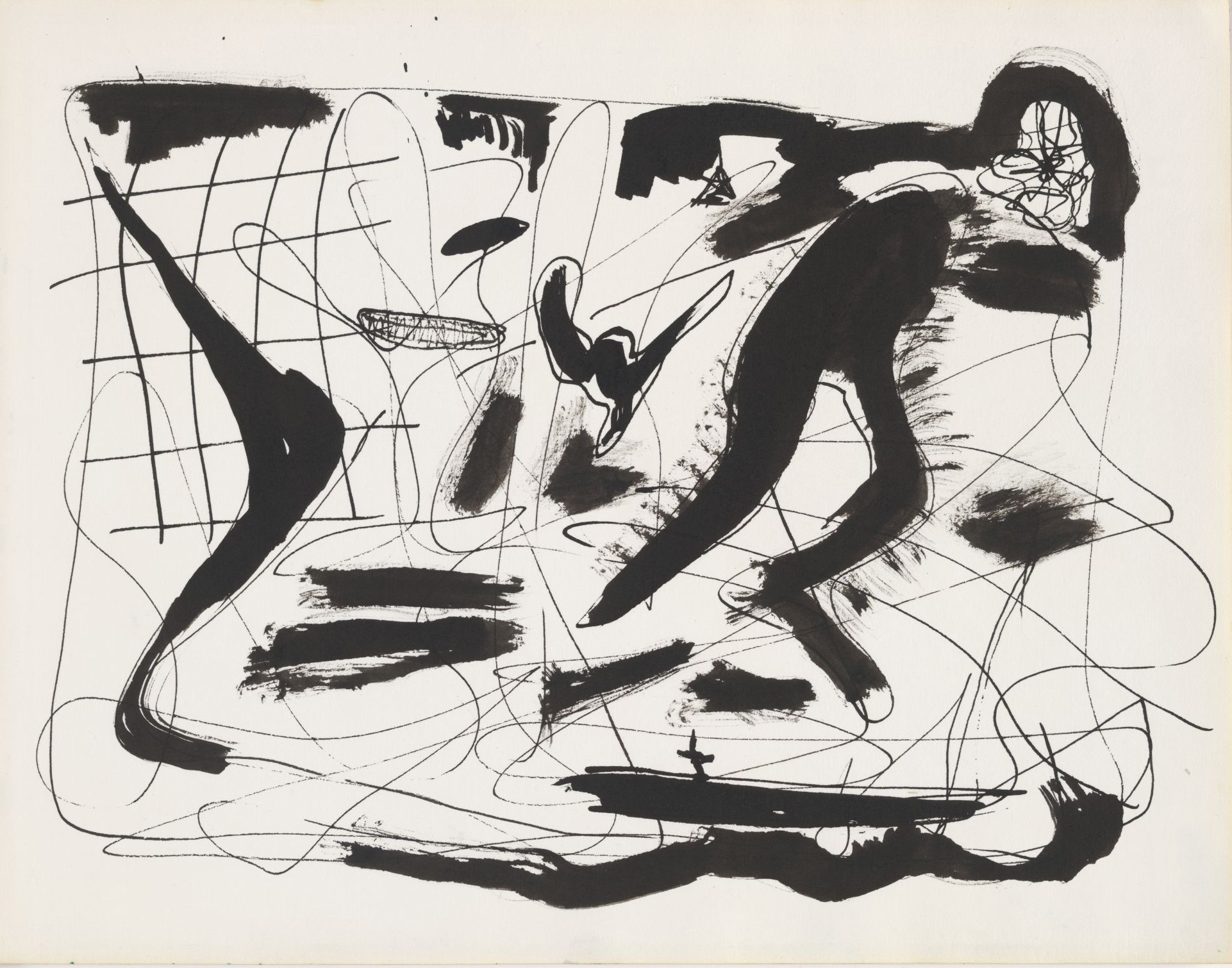
Mexican Sketchbook, Page 5, 1941
1941
On June 19 Motherwell travels with the group and Maria to Taxco, where they will spend the summer.
In the months that follow, Motherwell creates the ink drawings in the Mexican Sketchbook, his first sustained experiment in automatism.
1941
In the fall, Motherwell and Maria move to Mexico City at the invitation of the Austrian surrealist Wolfgang Paalen. Motherwell translates Paalen’s essay “The New Image” for Dyn, a new magazine Paalen is starting.
1941
In November, Motherwell and Maria return to New York, where meets André Breton, Max Ernst, and Peggy Guggenheim.
Breton chooses Motherwell to serve as one of the editors of VVV, the new journal of the Surrealists in America. In one of Motherwell’s first acts as editor, he invites William Carlos Williams to serve as a second American editor of the publication.
1942
Shortly before publication of the first issue of VVV in the spring, Motherwell is fired and replaced, first by Lionel Abel and then by David Hare. The issue is published in June with Motherwell’s essay, “Notes on Mondrian and Chirico.”
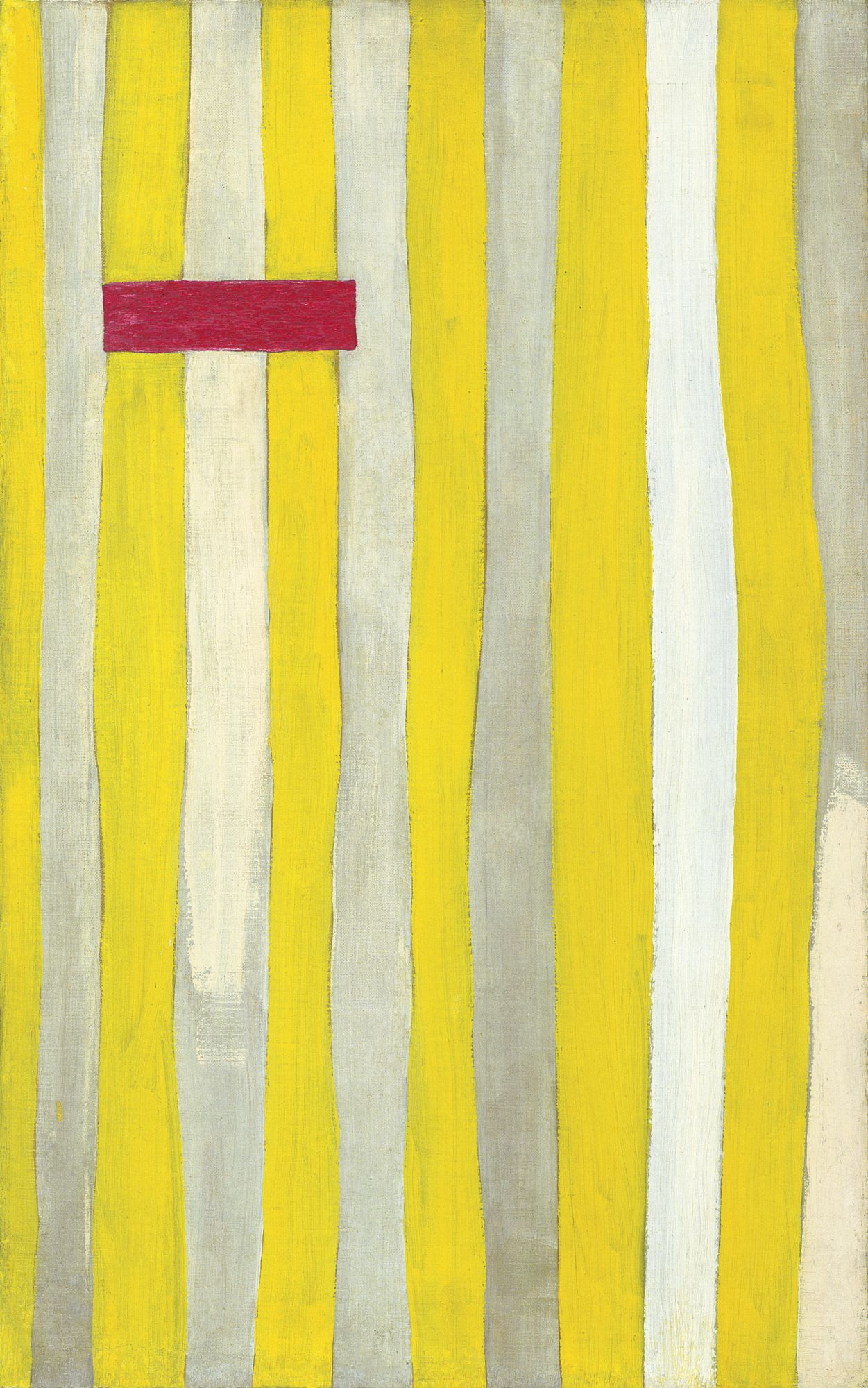
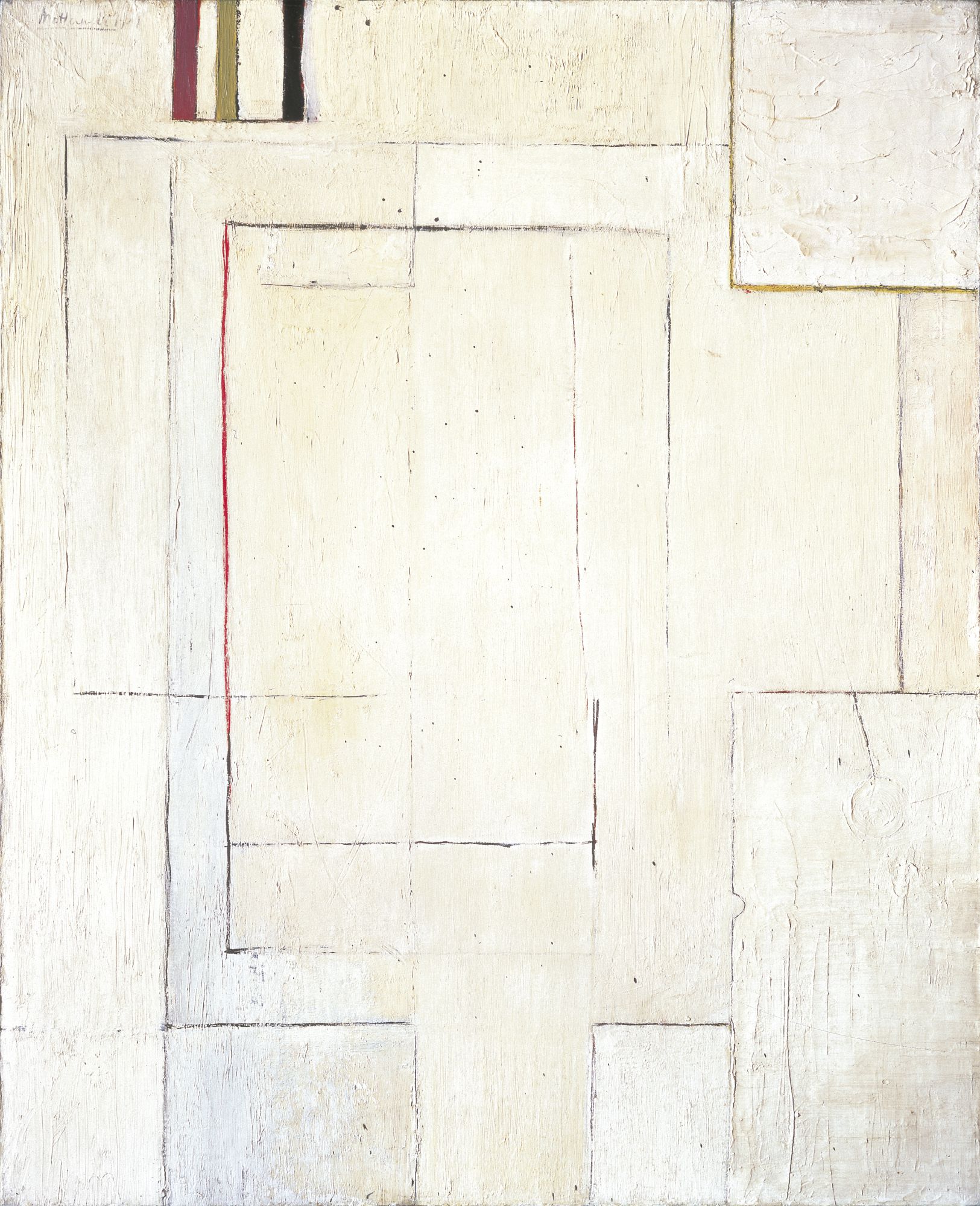
Works from this period include The Little Spanish Prison, whose color is inspired by the colors he had seen in Mexican folk art, and Spanish Picture with Window; both paintings reflect the impact of Mondrian’s work.
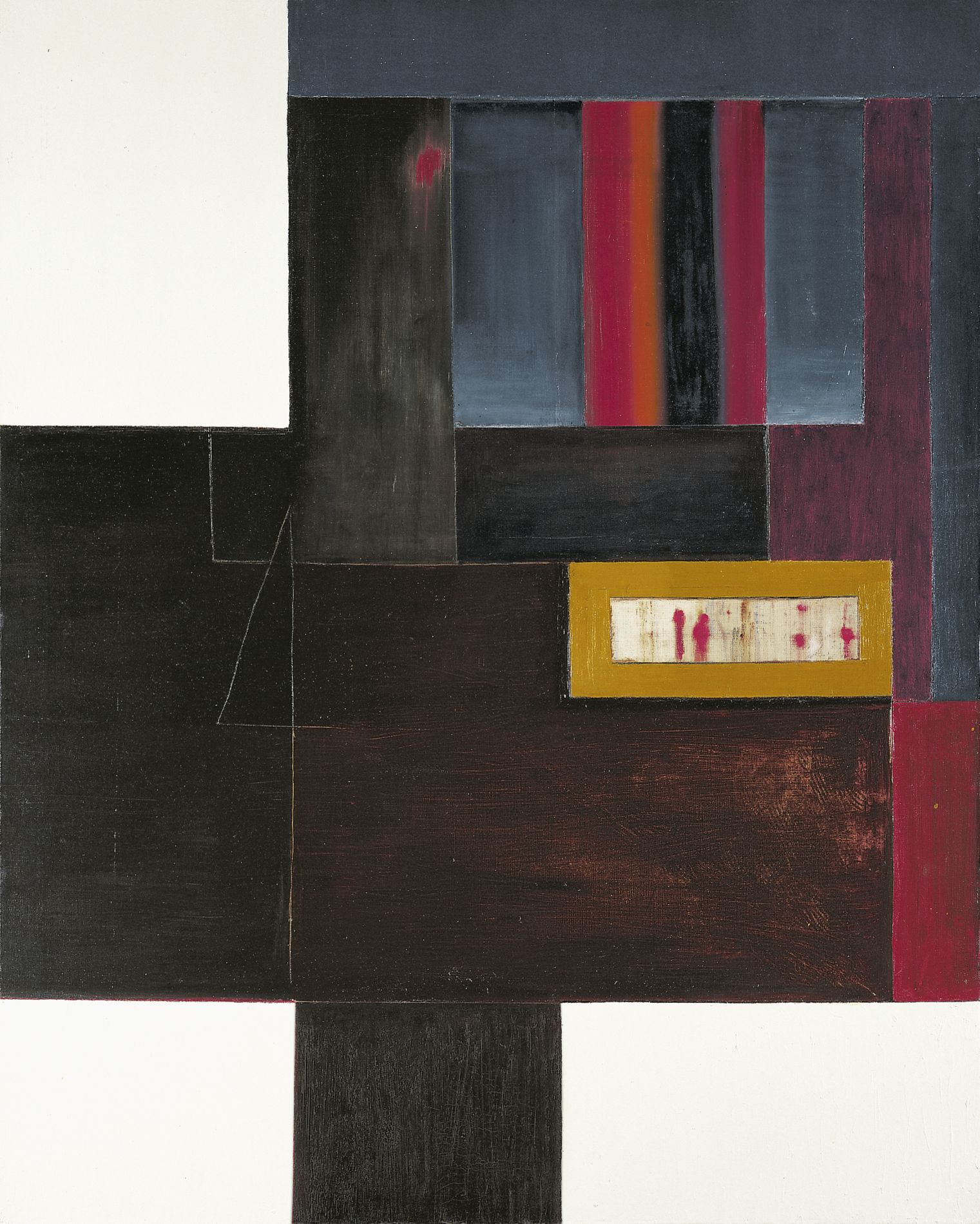
Recuerdo de Coyoacán, 1942
1942
Motherwell and Maria spend the summer in Provincetown, joined by the Mattas, Guggenheim, and Ernst. Recuerdo de Coyoacán clearly illustrates his efforts at this time to integrate surrealist automatism and the plastic integrity of Mondrian’s work.
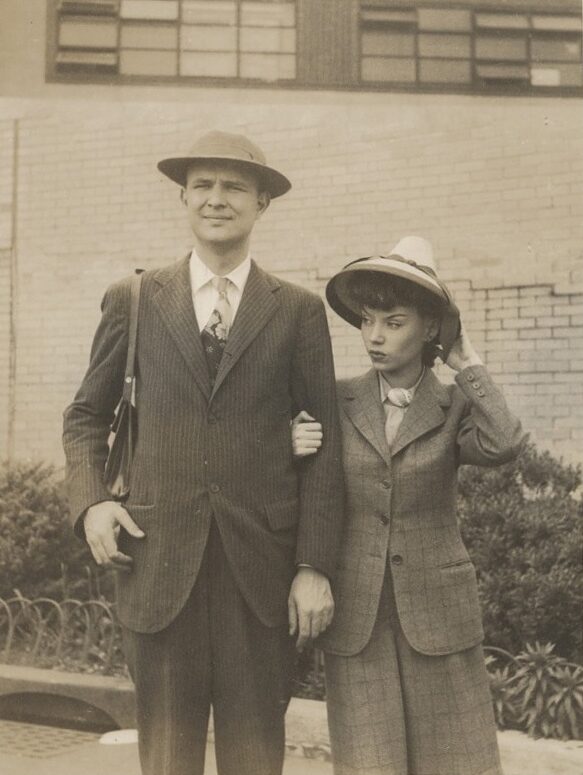
Robert and Maria Motherwell at LaGuardia Airport, May 1943
1942
Motherwell and Maria are married on August 16.
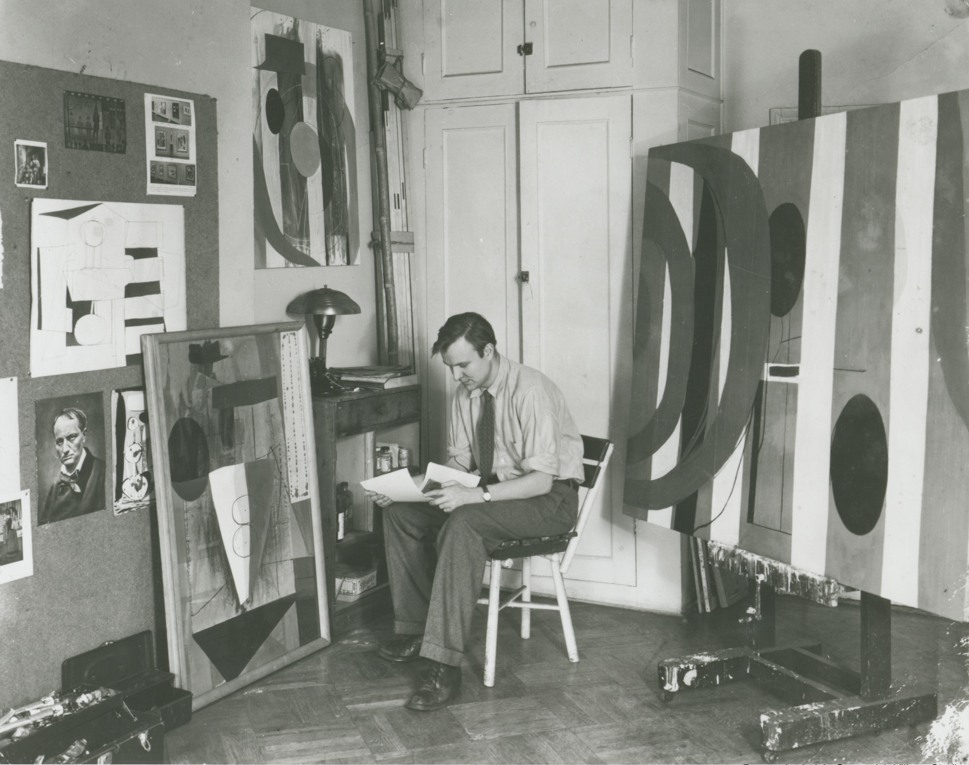
Motherwell in his Greenwich Village studio, ca. 1945
1942
In the fall, the Motherwells return to New York, where Motherwell meets John Cage and Marcel Duchamp.
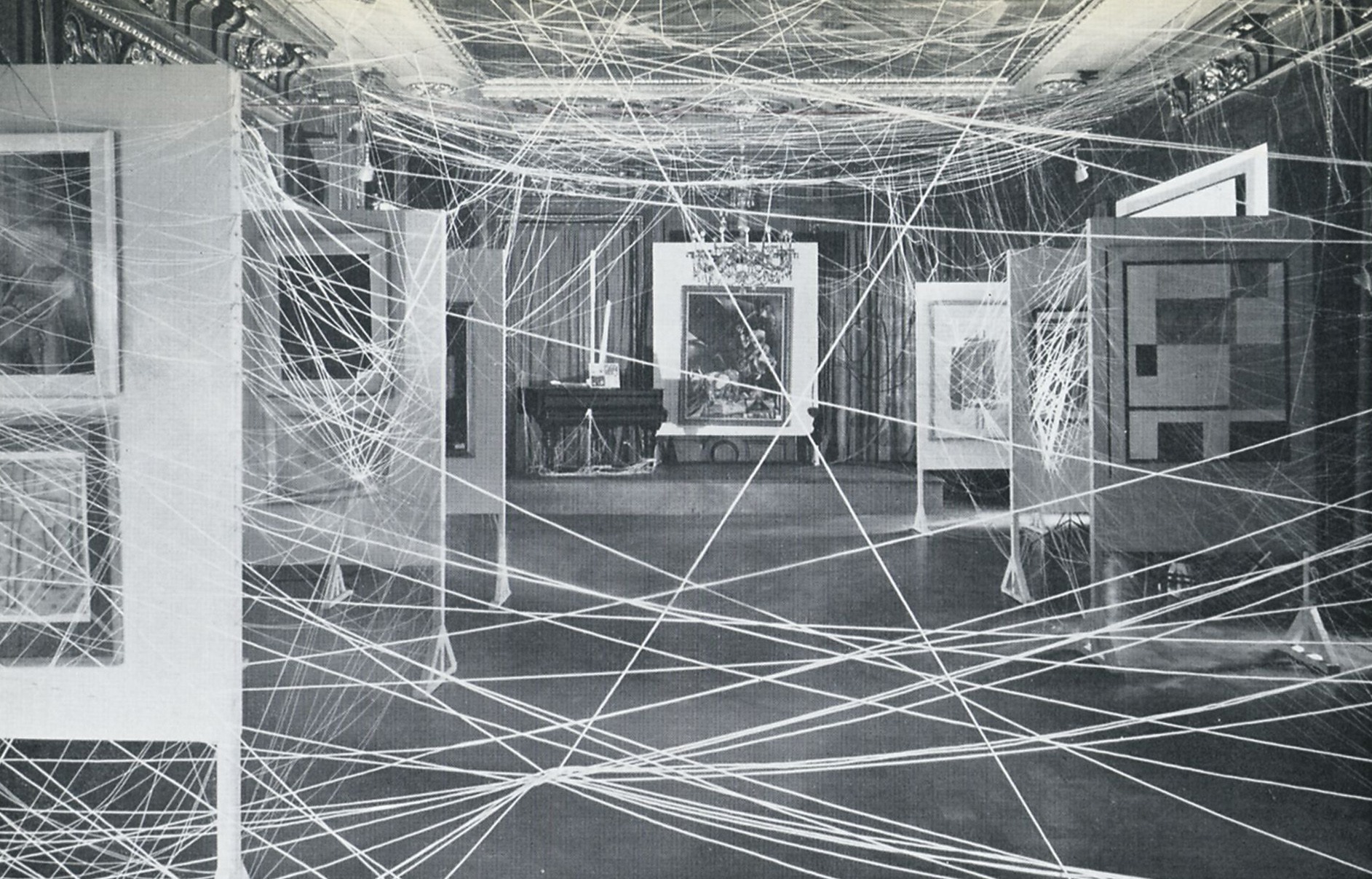
Installation view of First Papers of Surrealism at the Whitelaw Reid Mansion, New York, 1942. Motherwell’s painting is the first artwork on the right side
1942
In the fall, Motherwell’s work is included in First Papers of Surrealism, organized by Breton and Duchamp. It is his first exhibition in New York.
Guggenheim opens the Art of This Century gallery in mid-October to showcase her personal collection of modern art and to present exhibitions of new work. She invites Motherwell to exhibit at the gallery in the spring but he defers until 1944, feeling his work is not yet ready.
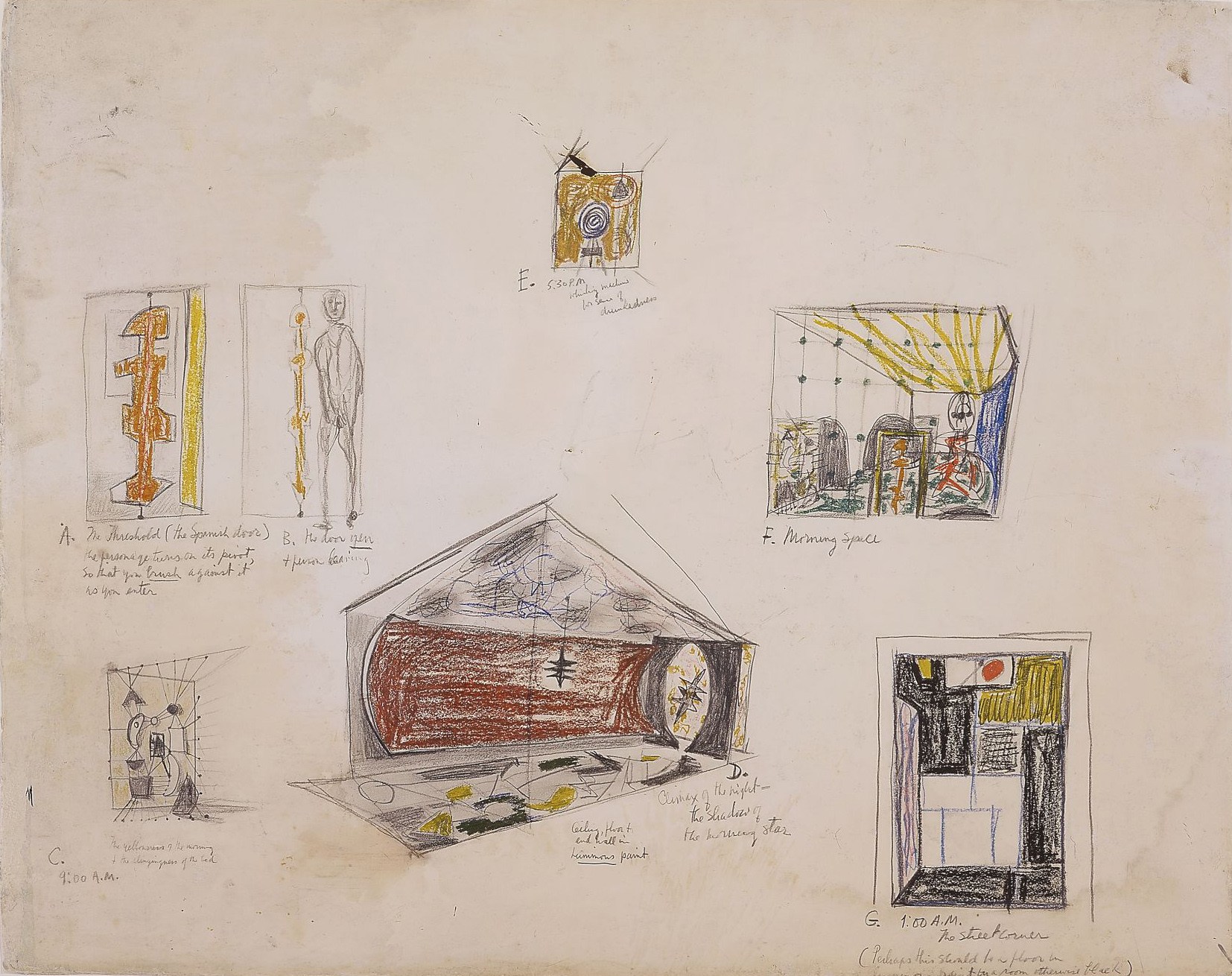
Untitled (drawing for Hours of the Day), ca. 1942
1942
William Baziotes, Jackson Pollock, Peter Busa, Gerome Kamrowski, and Motherwell begin meeting weekly at Matta’s apartment for experiments in automatist methods of making art.
Proceeding with Matta’s suggestion of the theme of “the hours of the day,” Motherwell creates a drawing for a total environment in the galleries of Art of This Century that combines sculpture, projected light, paintings, and painted walls.

Joy of Living, 1943
1943
Early in the year, Guggenheim invites Motherwell, Pollock, and Baziotes to make collages for an upcoming exhibition of collages, a relatively new medium in the United States. Pollock invites Motherwell to work in his studio, as neither artist has made collages before. Motherwell creates two collages during this session, which Matta sees shortly afterward. Matta enthusiastically urges him to make more and larger works in the medium.
In the weeks that follow, Motherwell creates the groundbreaking Joy of Living, which Guggenheim includes in her Exhibition of Collage that spring. Joy of Living is purchased by Saidie A. May for the Baltimore Museum of Art, the first work by Motherwell to enter a museum collection.

The Sentinel, 1943
1943
Motherwell’s painting The Sentinel, 1943 is included in the Spring Salon for Young Artists at Art of This Century and is acquired by Guggenheim for her collection.
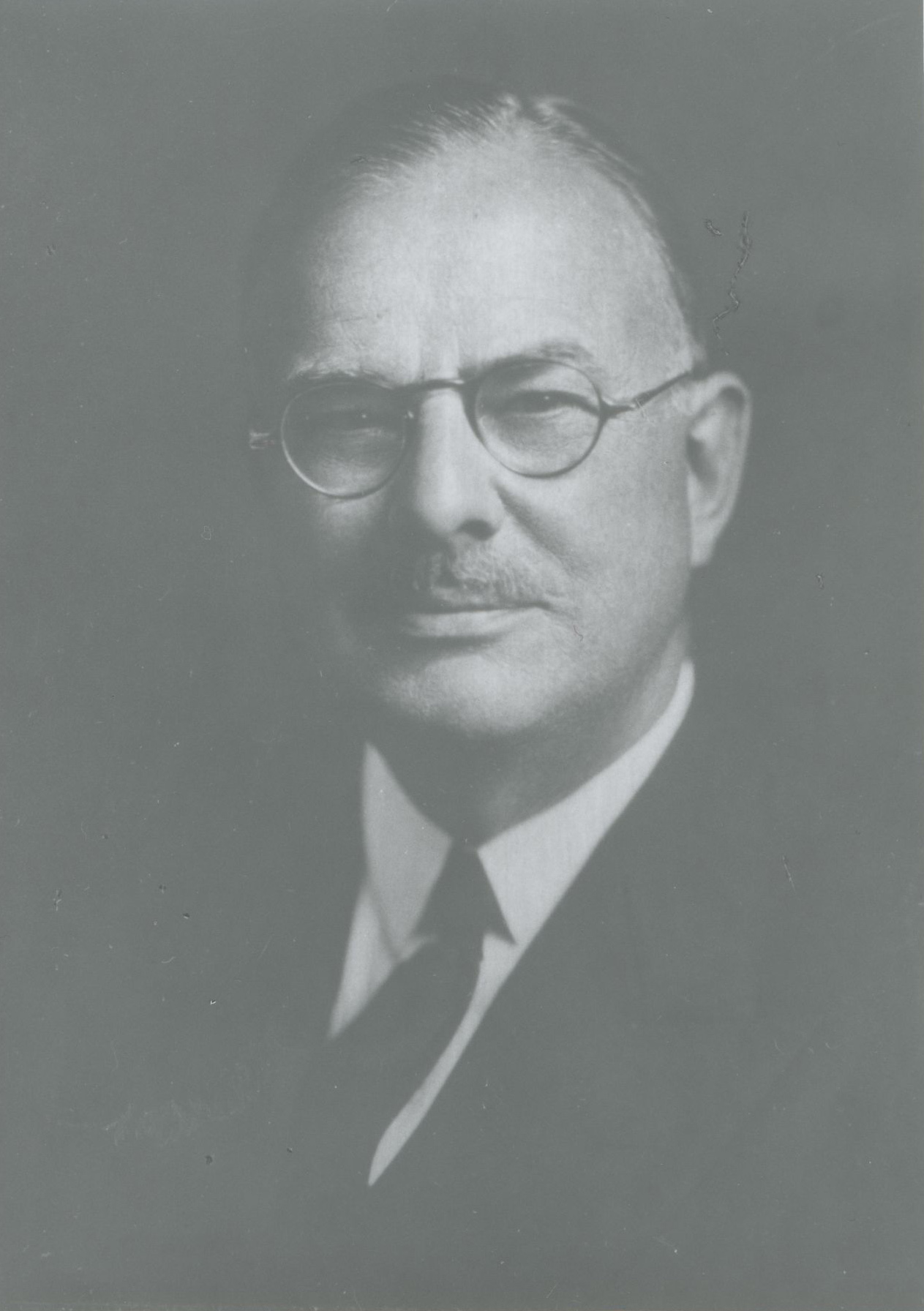
Motherwell’s father Robert Burns Motherwell II, ca. 1940
1943
During the summer, Motherwell travels to Mexico for a planned six month stay with Maria in Taxco. But in mid-August he receives word that his father is gravely ill with cancer. Motherwell immediately goes to San Francisco, where his father dies on August 29.
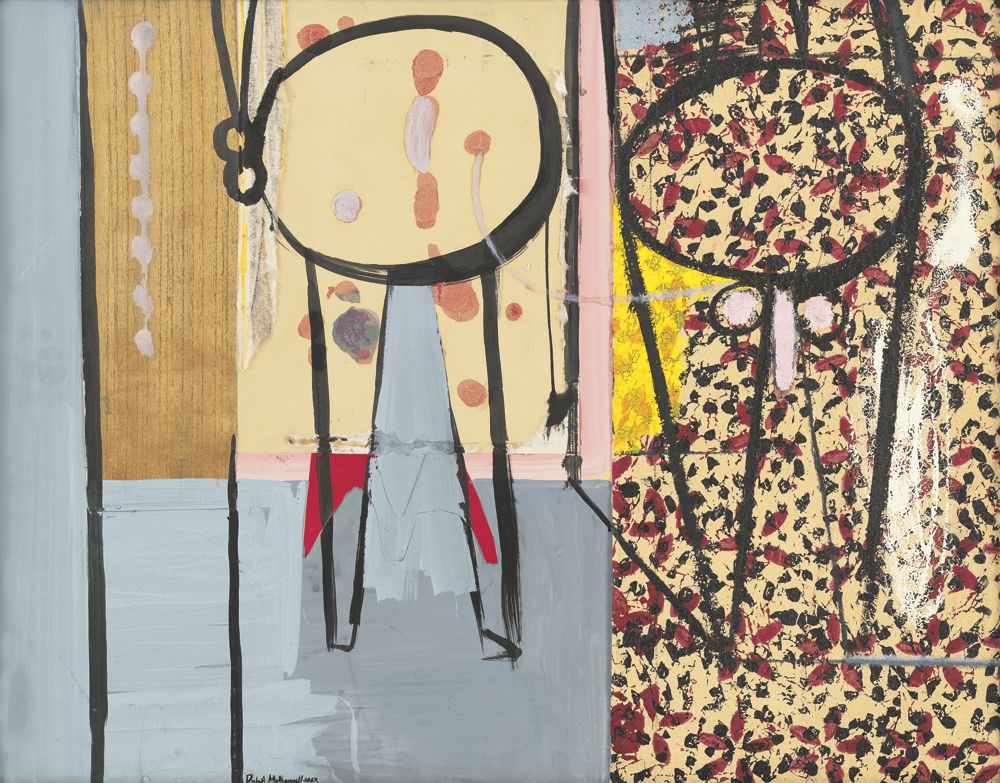
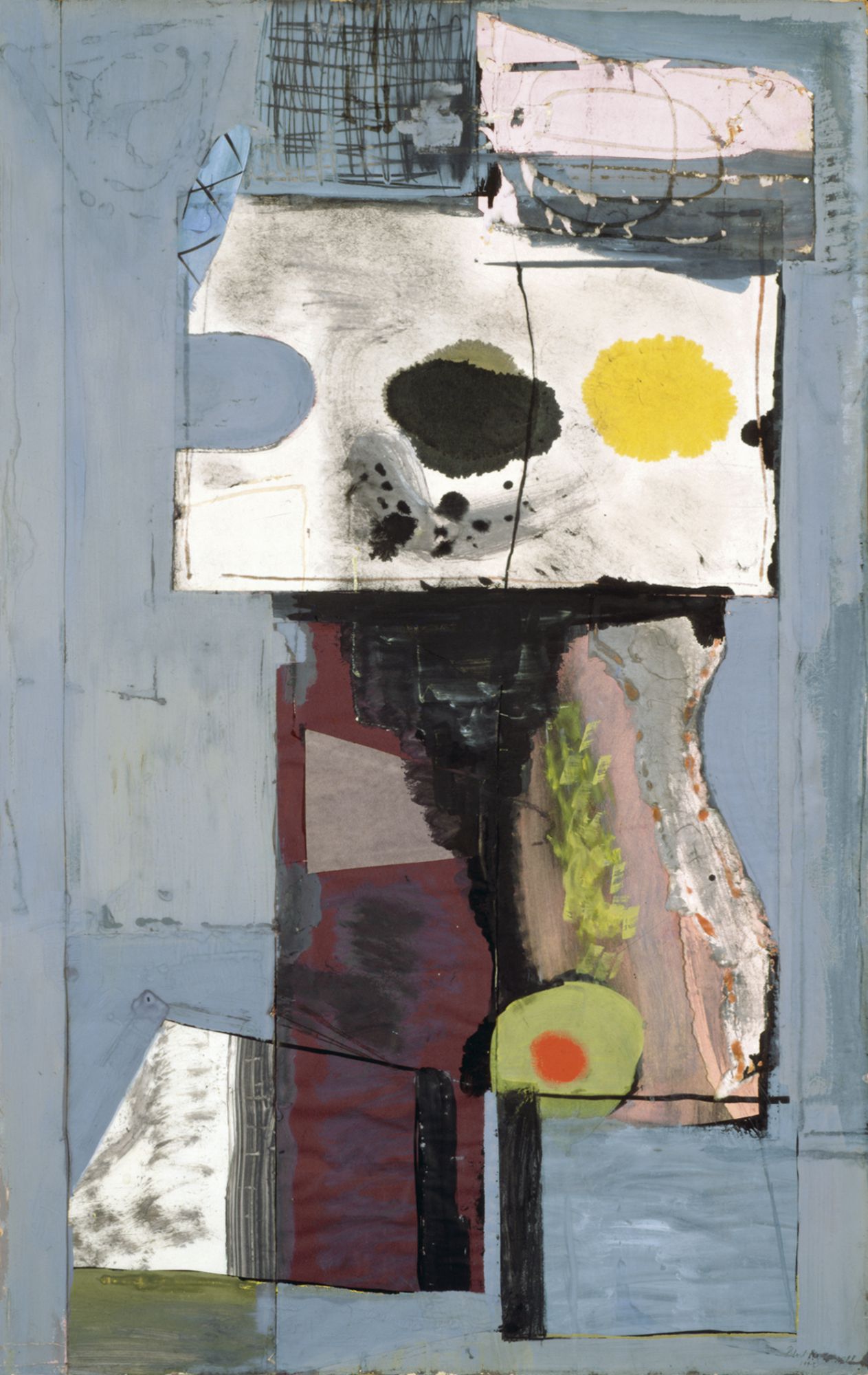
1943
On returning to New York, Motherwell creates a series of bold and dramatic new works that reflect his recent personal trauma and his ongoing interest in political themes, such as Pancho Villa, Dead and Alive and Personage (Autoportrait).
1944
Motherwell and the booksellers George Wittenborn and Heinz Schultz conceive of a series of affordable, paperback editions of writings by modern artists. Wittenborn and Schultz ask Motherwell to edit the series, which they name the Documents of Modern Art.

Max Ernst and Motherwell at Amagansett, N.Y., summer 1944
1944
Motherwell spends the summer in Amagansett, on Long Island, where he is introduced Motherwell to the French architect Pierre Chareau, who becomes a close friend and will later design a house for Motherwell. Ernst and Dorothea Tanning are among those spending the summer nearby.
1944
In the fall, Motherwell moves to Main Street in East Hampton. Guillaume Apollinaire’s The Cubist Painters is published as the first volume of Documents of Modern Art.
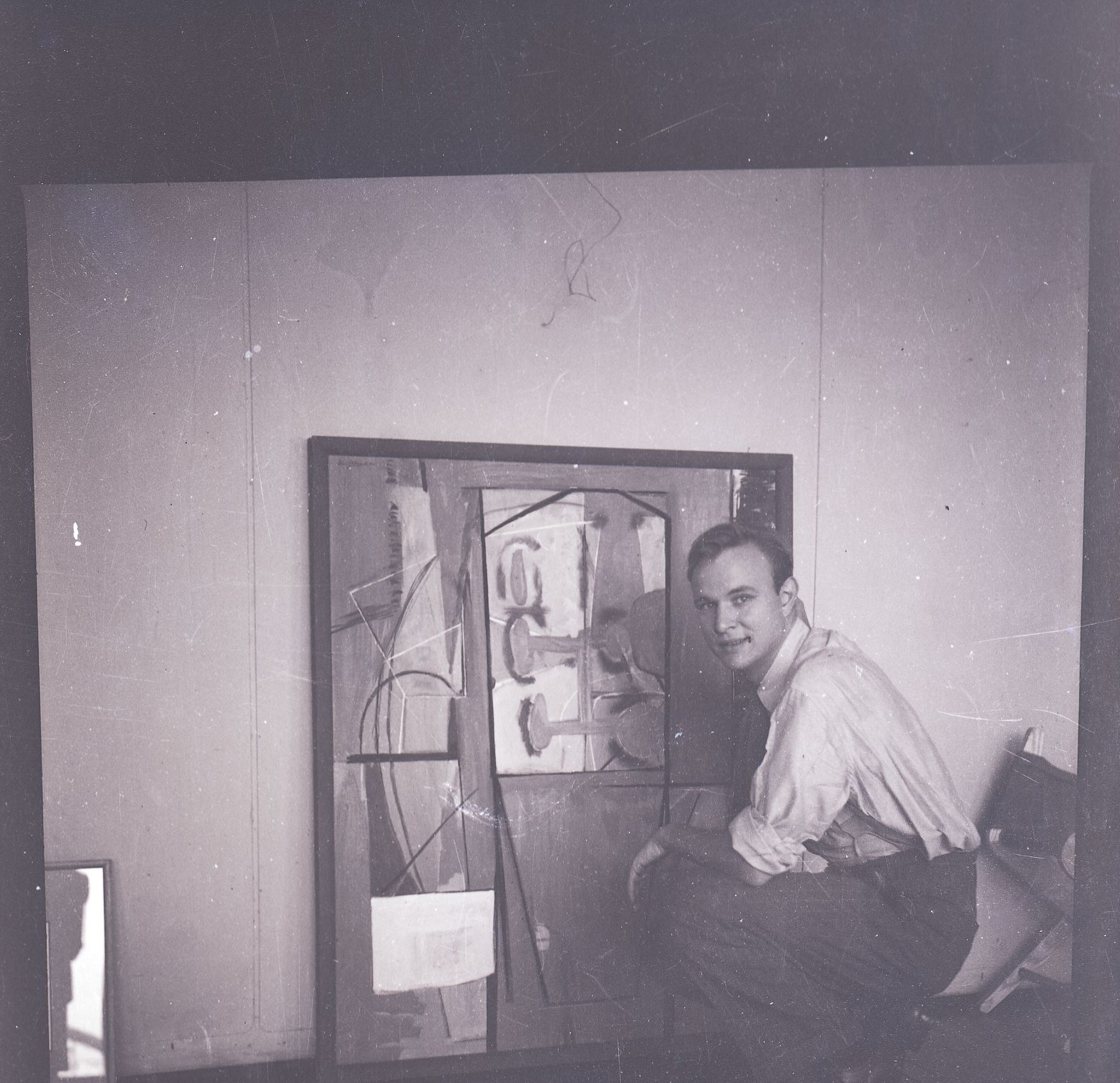
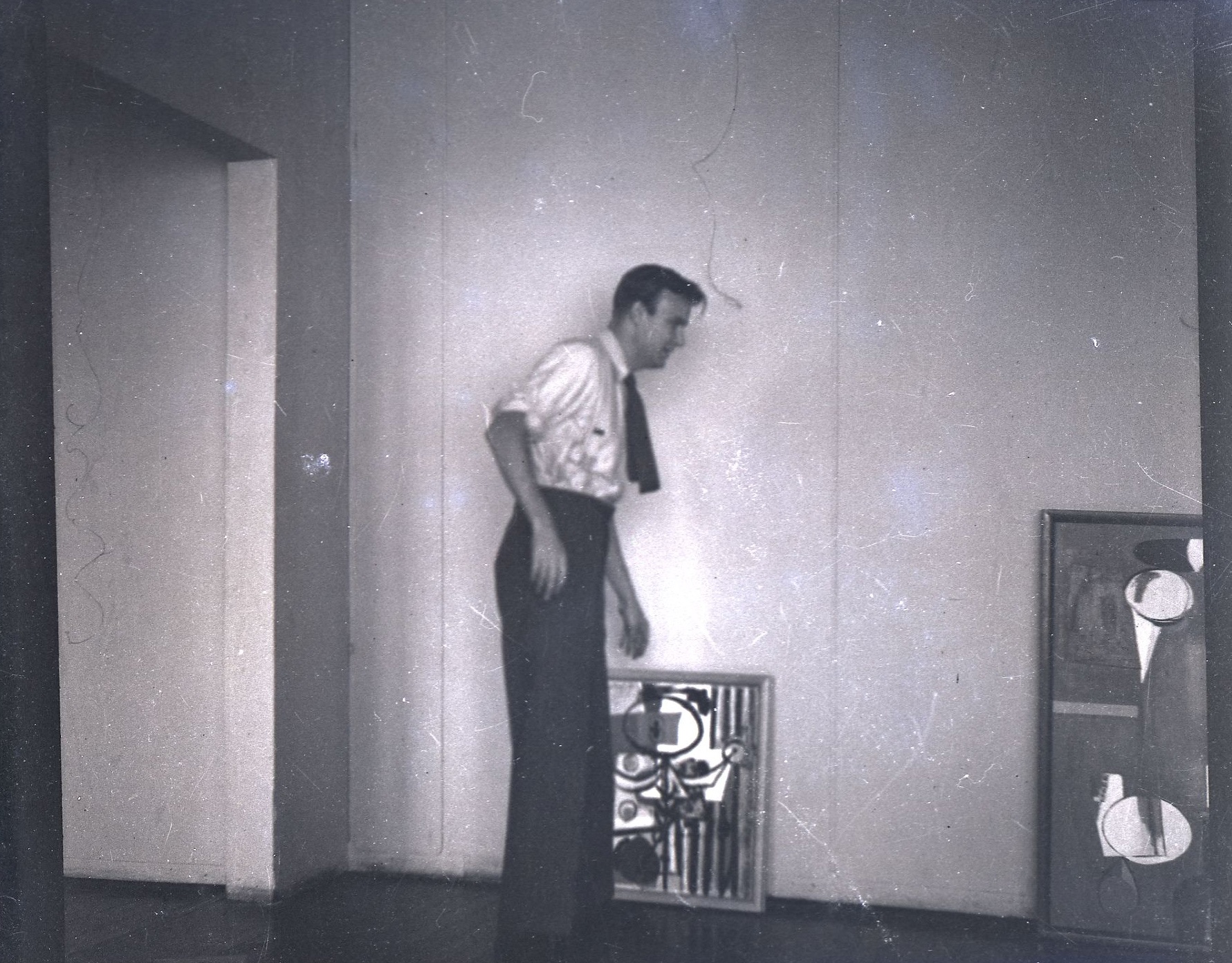
1944
On October 24, Robert Motherwell: Paintings, Papiers Collés, Drawings opens at Art of This Century with a catalogue essay by James Johnson Sweeney, a curator at the Museum of Modern Art; this is Motherwell first solo exhibition in New York.
1945
Motherwell signs a five-year contract with the Samuel M. Kootz Gallery, which promises him a monthly stipend in exchange for twenty-five oil paintings and collages, and fifty watercolors each year.
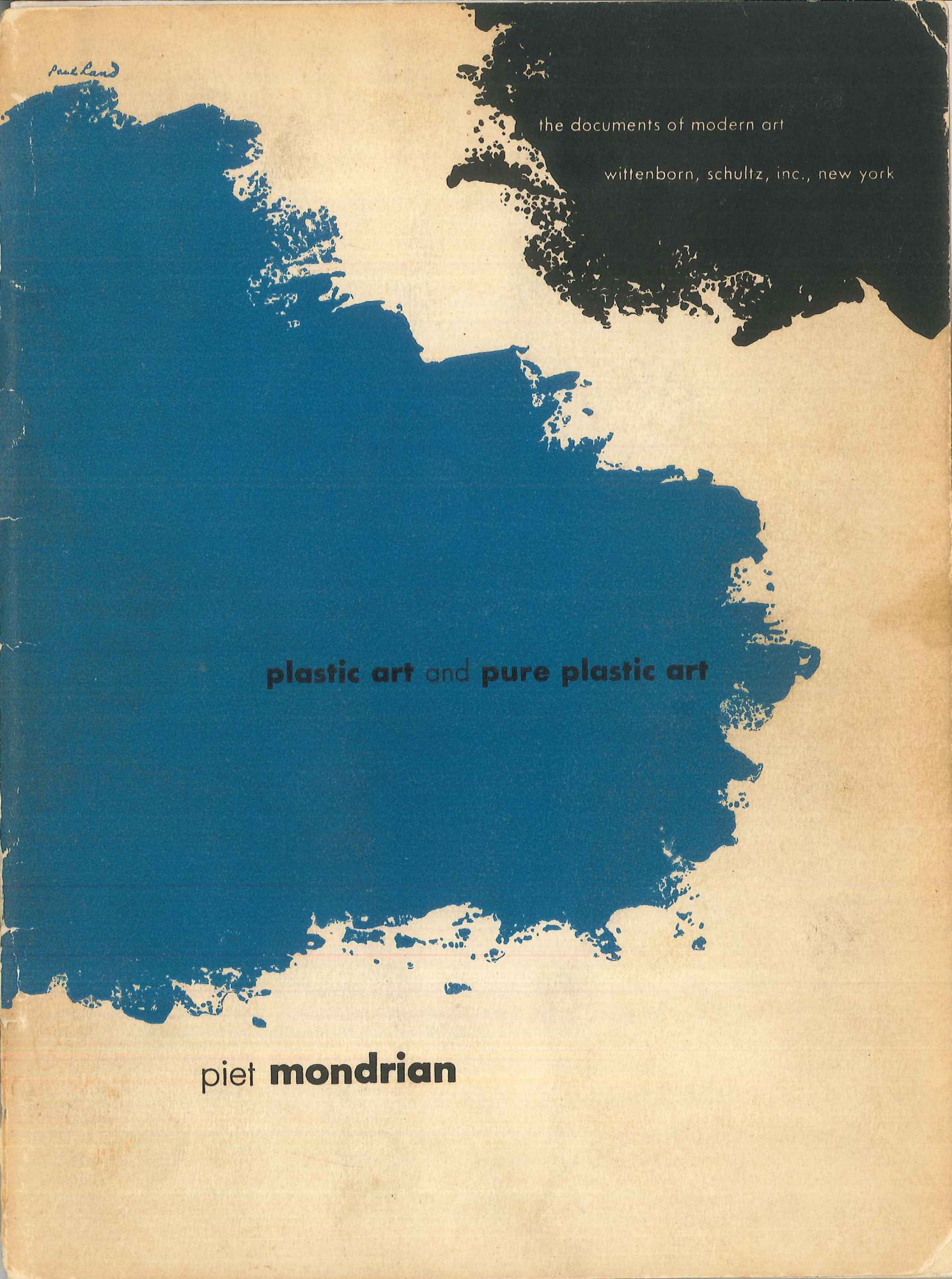
Motherwell’s copy of Piet Mondrian: Plastic Art and Pure Plastic Art, 1937, and Other Essays, 1941–1943
1945
Piet Mondrian: Plastic Art and Pure Plastic Art, 1937, and Other Essays, 1941-1943 is published as the second volume in the Documents of Modern Art series.
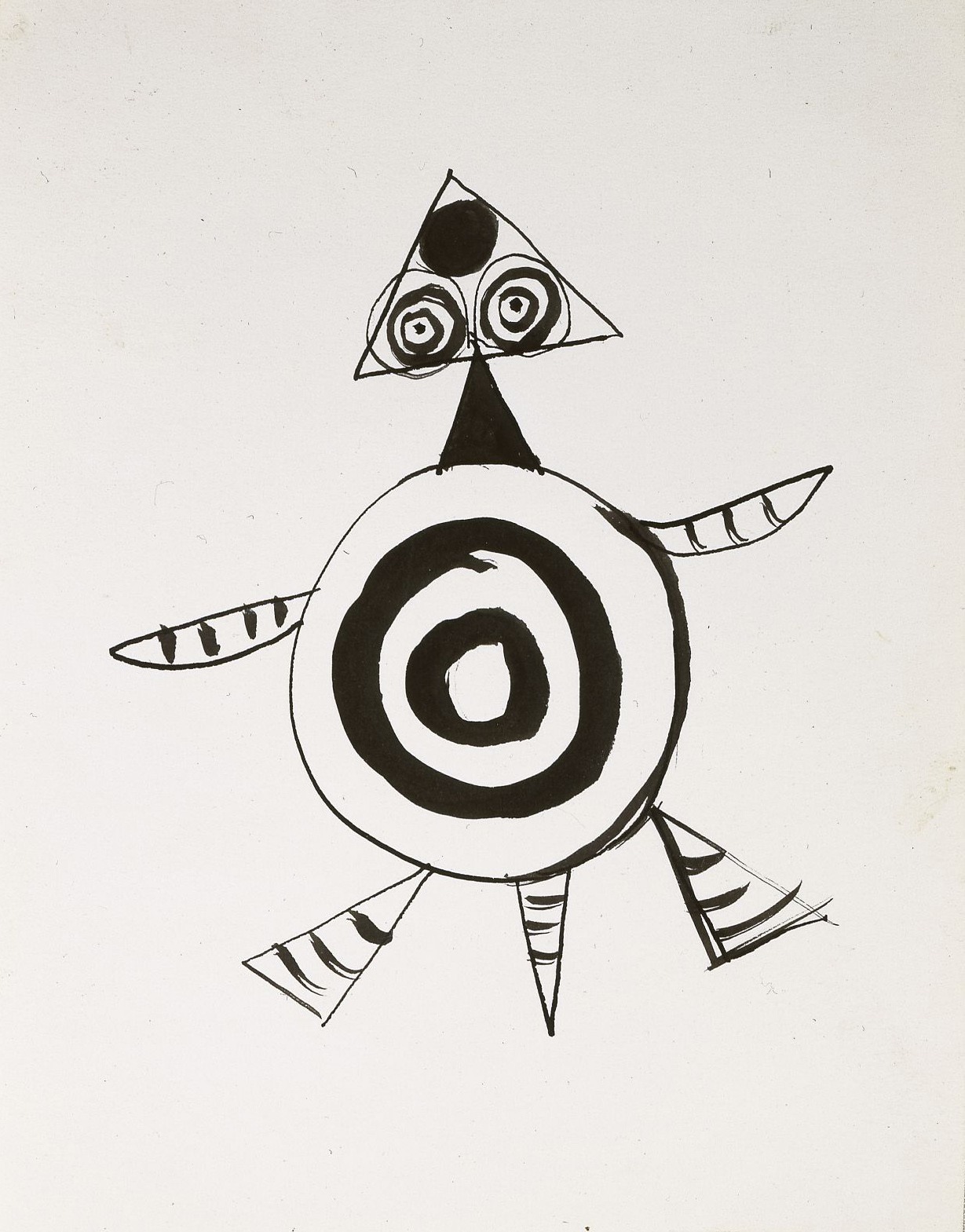
Tortoise, from La Fontaine’s Fables, 1945. Ink on paper, 6 ½ x 5 inches (16.5 x 12.7 cm)
1945
Reynal & Hitchcock commission him to illustrate Marianne Moore’s translation of La Fontaine’s Fables, for which he creates a number of drawings and collages; but the project is later abandoned.
Motherwell and Wittenborn acquire the rights to publish Georges Hugnet’s essay “L’esprit dada dans la peinture.” Motherwell’s work on Hugnet’s essay is inspired in part by his conversations with Dadaists, including Ernst and Duchamp, and is the beginning of what will be a seven-year engagement culminating in the publication of The Dada Painters and Poets as the eighth volume of the Documents of Modern Art series in 1951.
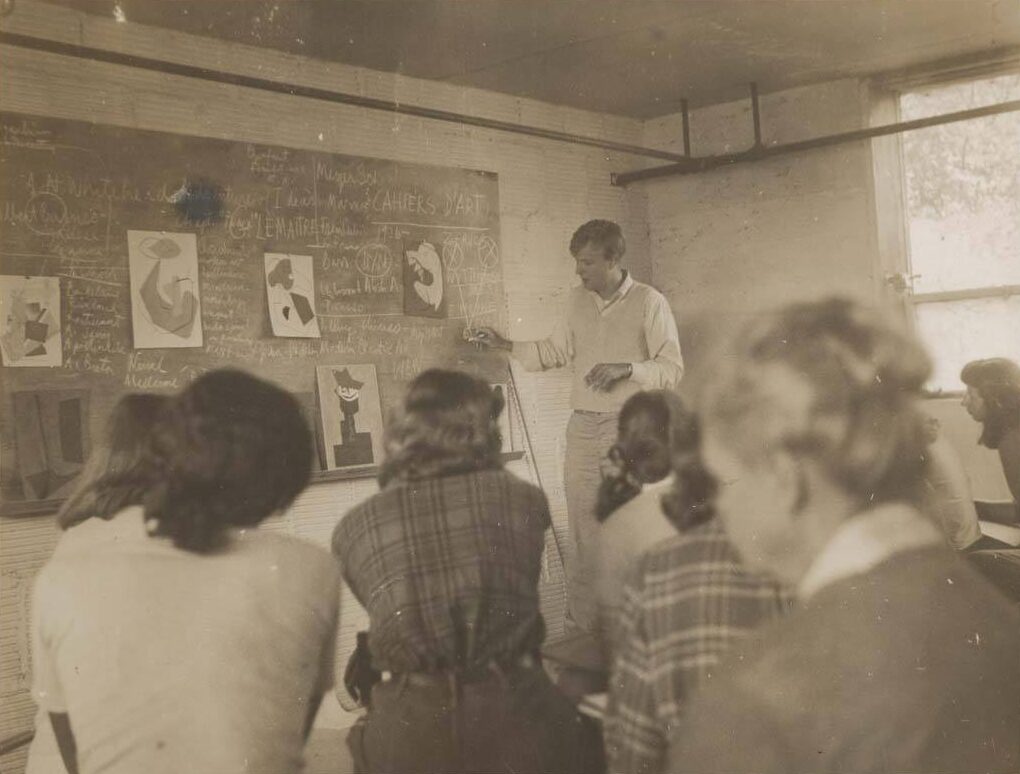
Robert Motherwell teaching at Black Mountain College, Asheville, N.C., summer 1945
1945
Motherwell teaches the second half of the summer session at Black Mountain College, near Asheville, North Carolina.
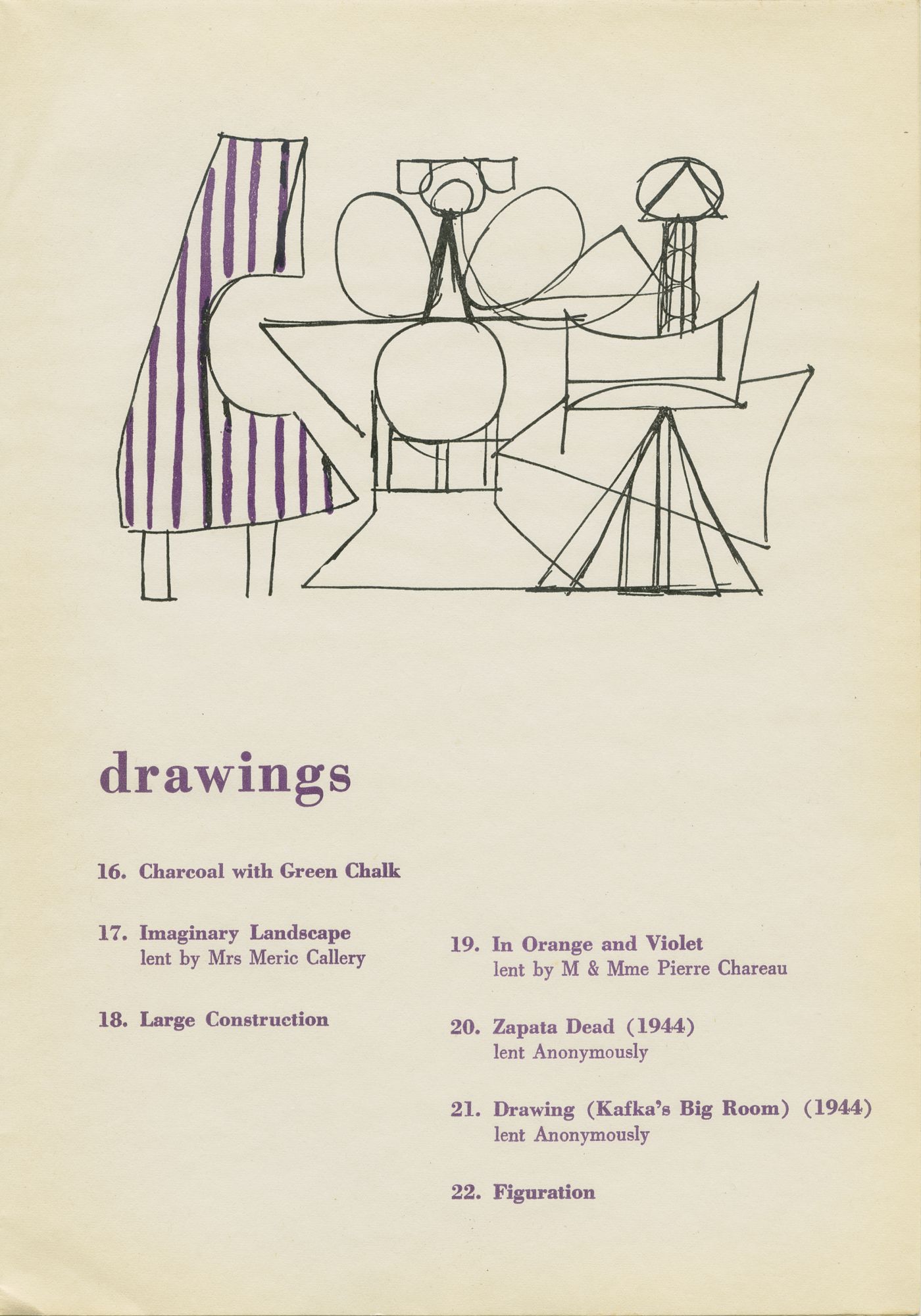
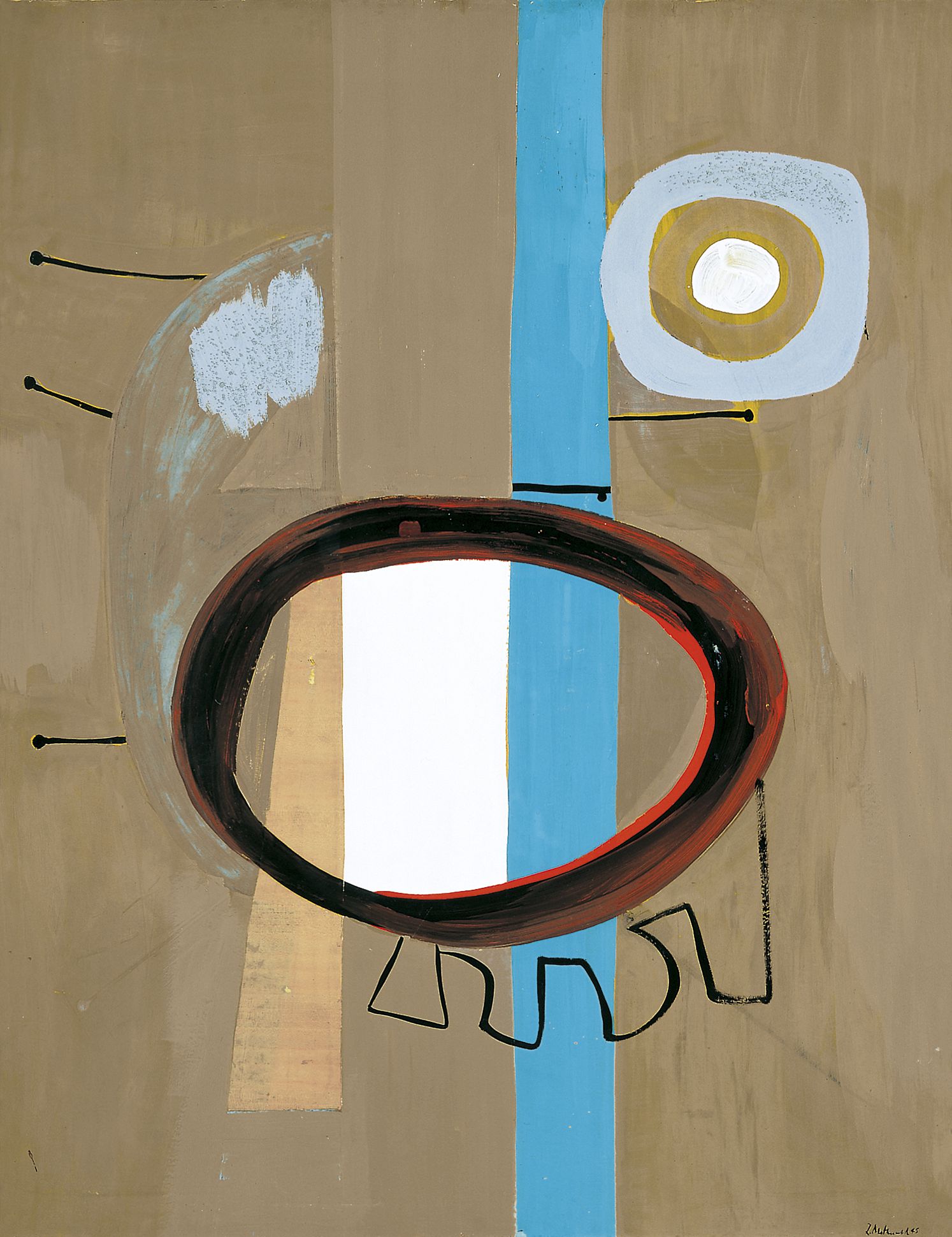
1946
In January, Robert Motherwell: Paintings, Collages, Drawings, an exhibition of 22 new works, opens at the Samuel M. Kootz Gallery. The Museum of Modern Art acquires In Beige With Sand from the exhibition.

Cover of the catalogue for Motherwell’s solo exhibition at the Arts Club of Chicago, February 1946
1946
In February, Robert Motherwell: Paintings, Collages, Drawings, an exhibition featuring thirty works from the past five years is shown at the Arts Club of Chicago; the show travels to the San Francisco Museum of Art.
1946
That summer, Motherwell becomes close friends with Mark Rothko, and through him, a wider circle of American artists, including Barnett Newman, Herbert Ferber, Tony Smith, and Bradley Walker Tomlin.
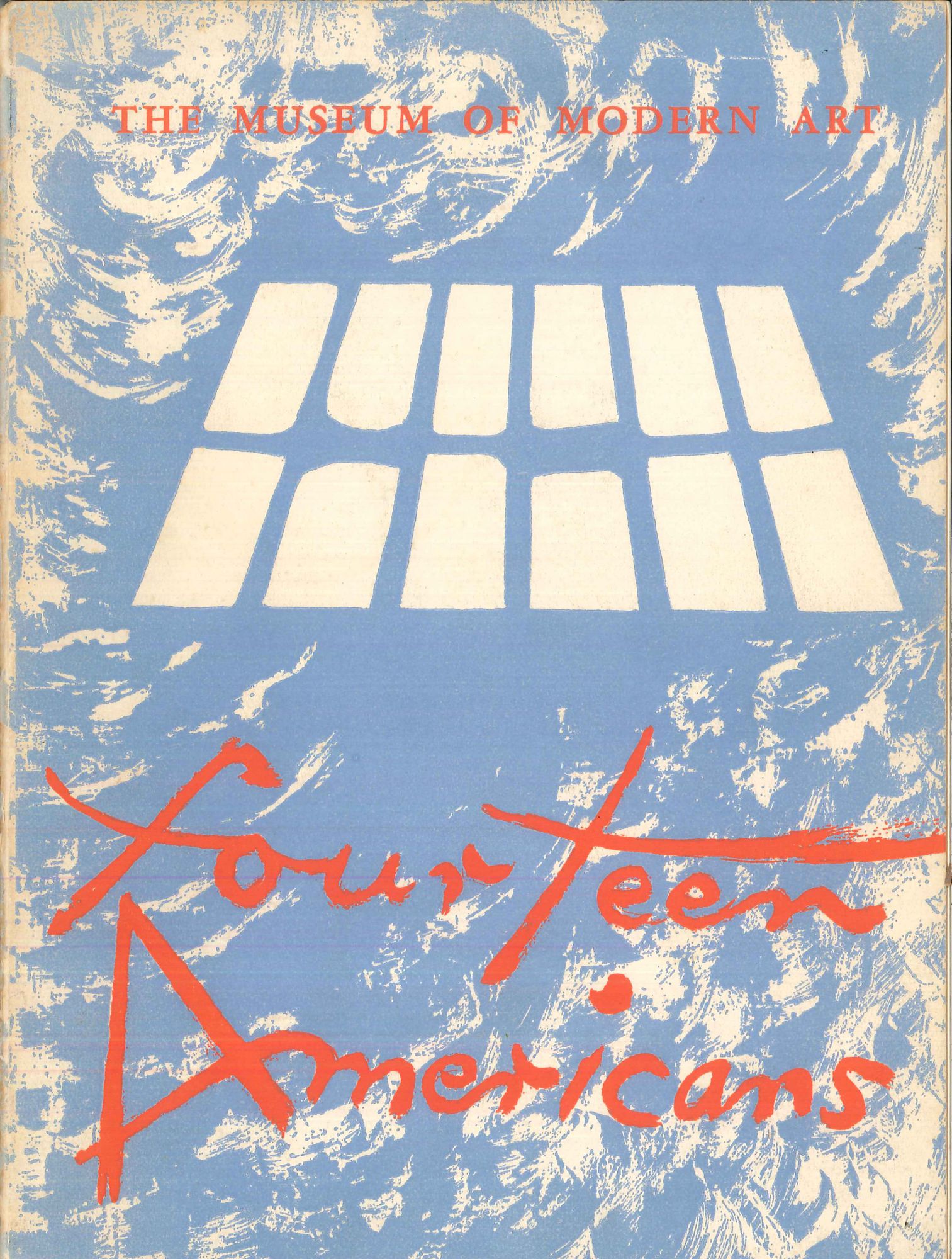
Cover of the catalogue for Fourteen Americans at the Museum of Modern Art, New York, September 1946
1946
On September 10, Fourteen Americans opens at the Museum of Modern Art.
The exhibition, curated by Dorothy Miller, includes several works by Motherwell, along with works by Arshile Gorky, Hare, Isamu Noguchi, Saul Steinberg, and Mark Tobey.
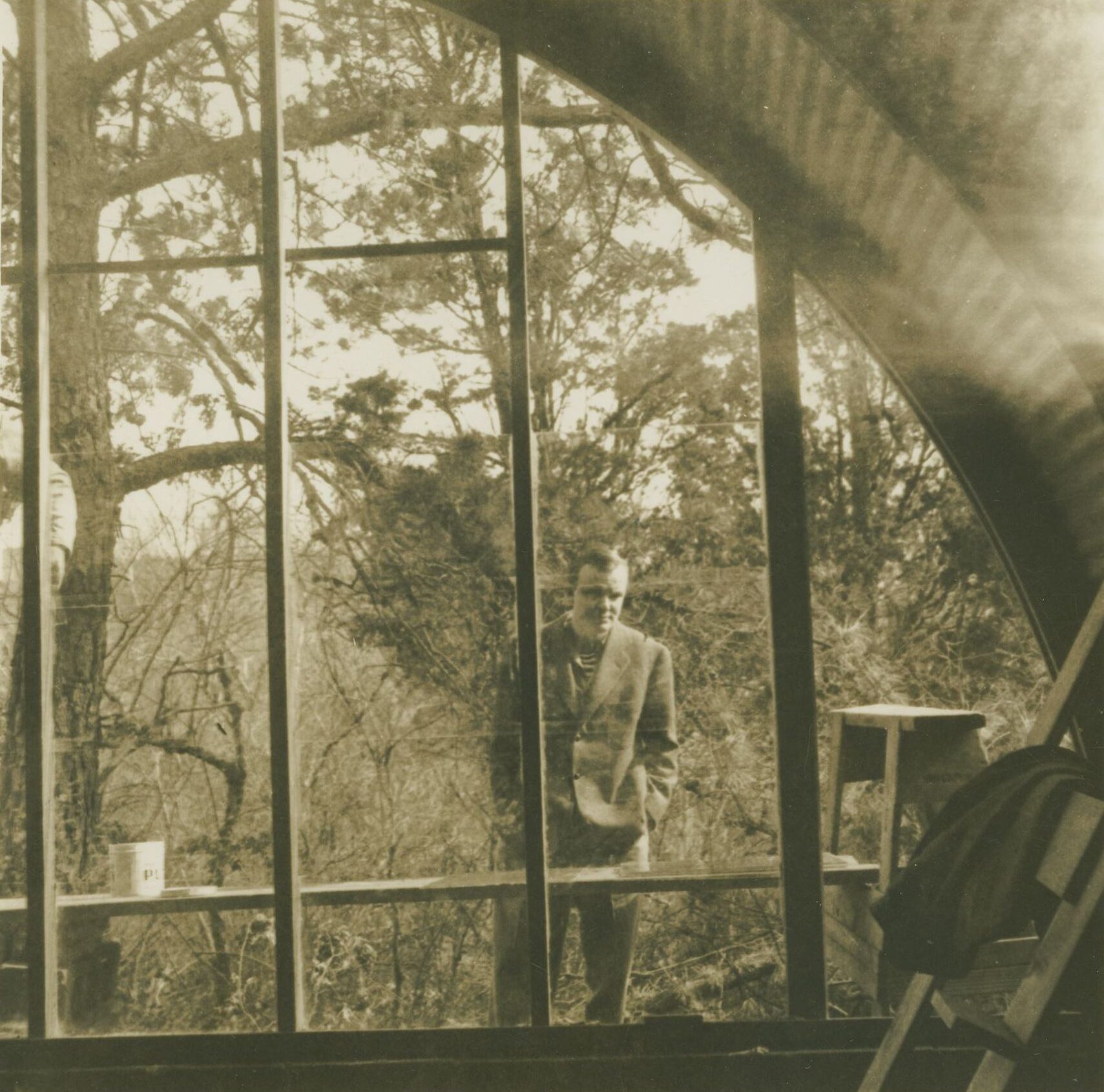
Motherwell observing the construction of his Quonset hut house and studio, 1946
1946
Toward the end of the summer, Motherwell purchases two acres of land in East Hampton, where he plans to build a house and studio complex using two salvaged Quonset huts designed by Architect Pierre Chareau.

The Poet, 1947
1947
In April, Motherwell has an exhibition of sixteen new works at the Samuel M. Kootz Gallery, which reflects a shift in his work towards a greater painterliness. The show features large oils such as Western Air and the collage The Poet.

Motherwell in the house designed by Pierre Chareau
1947
In late July, Motherwell moves into his new Quonset hut house in East Hampton, designed by Pierre Chareau. It is the first modern home built in the Hamptons.

Motherwell’s copy of Possibilities: An Occasional Review
1947
In October, Possibilities 1: An Occasional Review is published. Conceived by Motherwell and Harold Rosenberg, the journal has four editors, each overseeing a different discipline: Motherwell, art; Rosenberg, literature; Cage, music; and Chareau, architecture.
Motherwell and Rosenberg write in their introduction: “This is a magazine of artists and writers who ‘practice’ in their work their own experience without seeking to transcend it in academic, group or political formula…. If one is to continue to paint or write as the political trap seems to close upon him he must perhaps have the extremest faith in sheer possibility.”

